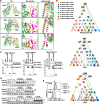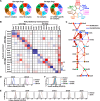Altered assembly paths mitigate interference among paralogous complexes
- PMID: 39169013
- PMCID: PMC11339298
- DOI: 10.1038/s41467-024-51286-w
Altered assembly paths mitigate interference among paralogous complexes
Abstract
Protein complexes are fundamental to all cellular processes, so understanding their evolutionary history and assembly processes is important. Gene duplication followed by divergence is considered a primary mechanism for diversifying protein complexes. Nonetheless, to what extent assembly of present-day paralogous complexes has been constrained by their long evolutionary pathways and how cross-complex interference is avoided remain unanswered questions. Subunits of protein complexes are often stabilized upon complex formation, whereas unincorporated subunits are degraded. How such cooperative stability influences protein complex assembly also remains unclear. Here, we demonstrate that subcomplexes determined by cooperative stabilization interactions serve as building blocks for protein complex assembly. We further develop a protein stability-guided method to compare the assembly processes of paralogous complexes in cellulo. Our findings support that oligomeric state and the structural organization of paralogous complexes can be maintained even if their assembly processes are rearranged. Our results indicate that divergent assembly processes by paralogous complexes not only enable the complexes to evolve new functions, but also reinforce their segregation by establishing incompatibility against deleterious hybrid assemblies.
© 2024. The Author(s).
Conflict of interest statement
The authors declare no competing interests.
Figures






Similar articles
-
Evolution of protein complexes by duplication of homomeric interactions.Genome Biol. 2007;8(4):R51. doi: 10.1186/gb-2007-8-4-r51. Genome Biol. 2007. PMID: 17411433 Free PMC article.
-
Lean forward: Genetic analysis of temperature-sensitive mutants unfolds the secrets of oligomeric protein complex assembly.Bioessays. 2014 Sep;36(9):836-46. doi: 10.1002/bies.201400062. Epub 2014 Jul 22. Bioessays. 2014. PMID: 25048147 Free PMC article.
-
Assembly reflects evolution of protein complexes.Nature. 2008 Jun 26;453(7199):1262-5. doi: 10.1038/nature06942. Epub 2008 Jun 18. Nature. 2008. PMID: 18563089 Free PMC article.
-
Hallmarks and evolutionary drivers of cotranslational protein complex assembly.FEBS J. 2024 Aug;291(16):3557-3567. doi: 10.1111/febs.16869. Epub 2023 Jun 1. FEBS J. 2024. PMID: 37202910 Review.
-
Structure, dynamics, assembly, and evolution of protein complexes.Annu Rev Biochem. 2015;84:551-75. doi: 10.1146/annurev-biochem-060614-034142. Epub 2014 Dec 8. Annu Rev Biochem. 2015. PMID: 25494300 Review.
Cited by
-
Stepwise order in protein complex assembly: approaches and emerging themes.Open Biol. 2025 Jan;15(1):240283. doi: 10.1098/rsob.240283. Epub 2025 Jan 15. Open Biol. 2025. PMID: 39809320 Free PMC article. Review.
References
MeSH terms
Substances
Grants and funding
LinkOut - more resources
Full Text Sources

